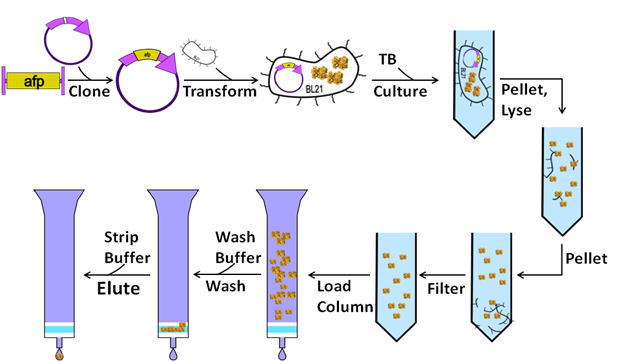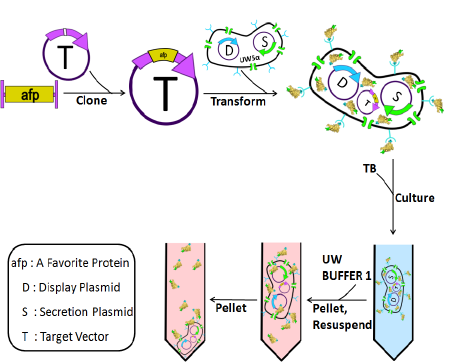Team:Washington/Project
From 2009.igem.org
Protein Purification
Purified proteins are an absolute necessity for aspiring synthetic biologists and iGEM participants alike, being used in many key laboratory processes. Though commonly used proteins like EcoRI, XbaI, SpeI, and PstI can be bought, those who research proteins and protein design, must purify their own proteins. Many of us have personal experience dully purifying protein, which makes the field as a whole slower and more tedious that it could be. For these reasons, the UW 2009 iGEM team has decided to design an Idealized Protein Purification (IPP) scheme that will speed up protein purification and possibly make previously difficult to purify proteins easier to work with, in the hopes to make synthetic biology a little faster, and a little more accessible.
Traditional Protein Purification
The first step of traditional protein purification schemes is cloning in a favorite protein (referenced here as afp) into an expression plasmid designed to generate lots of protein. This plasmid is then transformed into an expression strain of bacteria streamlined for protein production, which is then cultured, induced, and allowed to grow to high density. When they’re ready, these cells are pelletized and re-suspended in a lysis buffer, releasing all the proteins. After 30 minutes, the lysate is spun on an ultra-centrifuge for 1 hour to pellet insoluble cell debris, leaving soluble proteins in the supernatant. This supernatant is then filtered to remove any lingering debris before being added to an affinity column. After running the proteins through the column a few times, a wash buffer is used to eliminate proteins that non-specifically bind to the column. Finally an elution buffer is added, releasing your favorite protein. Though not necessarily hard, this process is tedious and time consuming, taking us about three and a half hours to complete on purification day. With this in mind, we created an idealized protein purification scheme that makes protein purification facile, that takes a fraction of the time older methods require.
Idealized Protein Purification
Our system is designed to secrete proteins of interest and then displays them on the cell’s surface, eliminating the lysis, filtration, and most centrifuge steps. First, clone a favorite protein into the target construct, an expression plasmid that adds a secretion tag and a display tag to the protein. Then transform the Target Vector into cells already containing the Secretion plasmid, which contains all the parts of a type 1 secretion system, and the Display plasmid, which expresses a protein that can non-covalently bond the display tag. Culture the colonies, and induce when appropriate. Once the proteins are ready to be collected, spin down the cells, and re-suspend in an elution buffer, which contains a small molecule that disrupts the binding between display tag and display protein, causing your protein to fall off into the media. Pellet the cells again and take the supernatant which contains your purified protein. This process should take about 10 minutes, quick enough to do between classes!
In addition to saving time, our idealized protein purification method has other potential advantages over older methods. By keeping the cells intact, contaminants are not released into the media, which should result in purer protein product. A host of proteins toxic to E. Coli could still be grown by secreting them before reaching high intra-cellular concentrations. Alternately, some proteins can’t properly fold in E. Coli, but by secreting these proteins into the appropriate media, they might fold correctly. Finally, there are some applications, such as detoxification, where it is desirable to secrete protein into the environment, which our system could be easily modified to do.
 "
"



